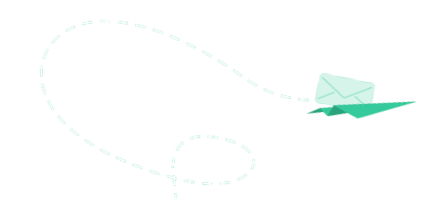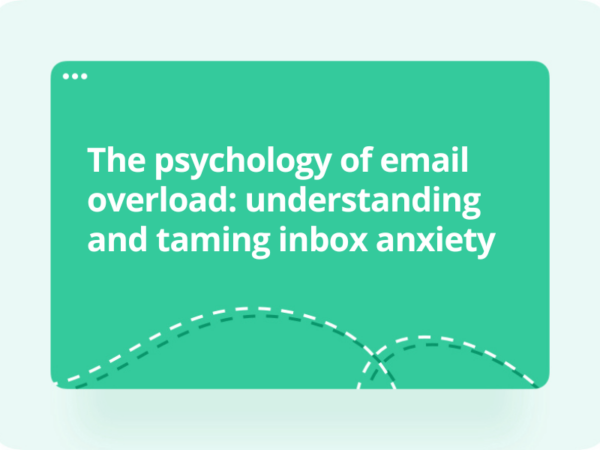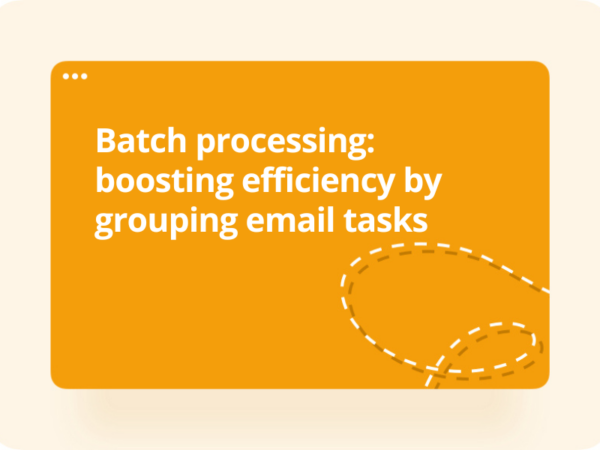Are you drowning in emails, feeling stressed and overwhelmed by the constant stream of messages flooding your inbox? You’re not alone.
Email overload is a common challenge that many of us grapple with daily. It’s not just a minor inconvenience; it can have significant repercussions, including reduced productivity, increased stress levels, and even lead to missing important messages.
Thankfully, a simple yet powerful strategy can come to your rescue: batch processing.
In this blog, we’ll shine a spotlight on batch processing. We’ll show you how this method can be your ally in the battle against email overload, transforming your email management experience by streamlining tasks and boosting overall productivity.
Say goodbye to the days of drowning in your inbox and hello to efficient email management.
What email batching?
Email batching is the process of managing your inbox in a more organized and efficient manner.
Instead of constantly checking and responding to emails as they arrive throughout the day, batch processing encourages you to collect and group similar email tasks together.
This approach aims to reduce interruptions, increase productivity, and streamline email management. It achieves this by allowing you to focus on email-related tasks in focused bursts rather than being constantly reactive to incoming messages.
By grouping email tasks into batches, you can boost your efficiency and regain control over your inbox.
How to carry out batch processing for emails
Batch processing emails is a straightforward process that can be achieved in a few simple steps:
1. Categorize your emails
Create folders or labels within your inbox to categorize your emails based on their content or source. Common categories include work-related emails, personal correspondence, newsletters, and specific project-related folders.
2. Set specific email processing times
Spend less time on email management by choosing specific times during your workday when you will focus solely on your inbox.
For example, you might allocate 20-30 minutes in the morning, another 20-30 minutes after lunch, and a final session before you finish your workday.
3. Create a workflow for batch processing
During your designated email processing times, follow this workflow:
- Review: Start by going through each email in your batch. If you receive emails that are irrelevant, delete them immediately.
- Respond and act: Address the rest of your emails systematically. Reply to messages that require responses, take action on tasks, or delegate as necessary.
- File or archive: After dealing with an email, move it to the appropriate folder or archive it if you don’t need it for reference. This keeps your inbox clutter-free.
- Schedule follow-ups: For emails that require more time or follow-up actions, schedule these tasks on your calendar or add them to your to-do list.
4. Limit email distractions
Take control of your inbox by turning off email notifications outside your designated processing times.
This simple step minimizes interruptions, allowing you to stay focused and fully engaged in other important tasks.
It’s a small adjustment that can greatly affect your job productivity.
5. Reflect and adjust
Regularly assess your batch processing approach and adjust as needed to improve your efficiency and effectiveness.
You can successfully implement batch processing for your emails by following these steps. This method helps you regain inbox control, check emails, reduce email-related stress, and improve overall productivity.
6. Leverage email management tools
Explore email management tools and plugins that can further enhance your batch email-processing experience.
These tools often offer features like email tracking, advanced filtering, and automated categorization, which can streamline email tasks.
How to reduce email overload
Managing email overload can be a daunting task. Thankfully, some practical strategies and techniques can help you regain control of your inbox and reduce the stress associated with a flooded email account.
Here are some practical tips and tricks to make email overload more manageable:
- Use keyboard shortcuts: Familiarize yourself with keyboard shortcuts for everyday email actions (e.g., reply, archive, delete).
- Snooze or schedule emails: Use email tools that allow you to snooze emails or schedule them to be sent later. This can help you control when you deal with specific messages and reduce the urgency to respond immediately.
- Set clear email policies: Establish clear email communication policies within your organization or among your contacts. For instance, specify response times for non-urgent messages.
- Unsubscribe and filter: Regularly unsubscribe from newsletters and promotional emails you no longer need. Create filters or rules to automatically categorize, archive, or forward emails based on sender or keywords.
- Use email templates: Create templates for common email responses or inquiries to save time on repetitive tasks.
- Batch similar tasks: Beyond emails, apply batch processing principles to other tasks. Group similar activities, such as meetings, phone calls, or data entry, into specific time blocks during your workday.
- Mindful email etiquette: This includes using clear subject lines, avoiding excessive use of “reply all,” and providing context in your emails.
- Delegate email tasks: If you have team members or assistants, delegate certain email-related tasks to them, such as sorting, filtering, or responding to routine inquiries.
- Regularly declutter: Set aside time to declutter your email folders. Delete or archive old and unnecessary emails to free up space and reduce visual clutter.
- Stay informed: Keep up with updates and features in your email client. Many email platforms introduce new tools and functionalities to enhance email management.
If you’ve been struggling with email overload and the constant barrage of messages in your inbox, batch processing is your solution.
You can regain control of your inbox, enjoy a better work-life balance, and boost productivity by categorizing all the emails you receive, setting certain times for processing, creating a workflow, and leveraging email management tools.
Combine these strategies with practical tips like using keyboard shortcuts, setting clear email policies, and staying organized to make email overload more manageable.
With these techniques in your arsenal, you can bid farewell to email-induced stress and say hello to efficient email management and a more productive workday.
Discover InboxFreedom’s AI-powered email management tool
Unlock a new era of email management with InboxFreedom, the ultimate companion for professionals aiming to conquer their overflowing inboxes and reclaim their precious time.
InboxFreedom stands out with its innovative, time-saving tools and email automation prowess, redefining how you handle your messages.
No matter which email provider you prefer, be it Microsoft Outlook, Yahoo, or Gmail, InboxFreedom seamlessly integrates with your choice, ensuring a smooth transition.
With InboxFreedom, you can effortlessly unsubscribe from unwanted emails and wield customized email filters that grant you unprecedented control over your inbox.
Join our waitlist today and be at the forefront of the personalized and efficient world of InboxFreedom.
By signing up, you’ll gain exclusive early access to all the advanced features that will transform your email management. Don’t miss out – secure your spot now.
Sign Up For Our
AI-Powered Inbox Waitlist




